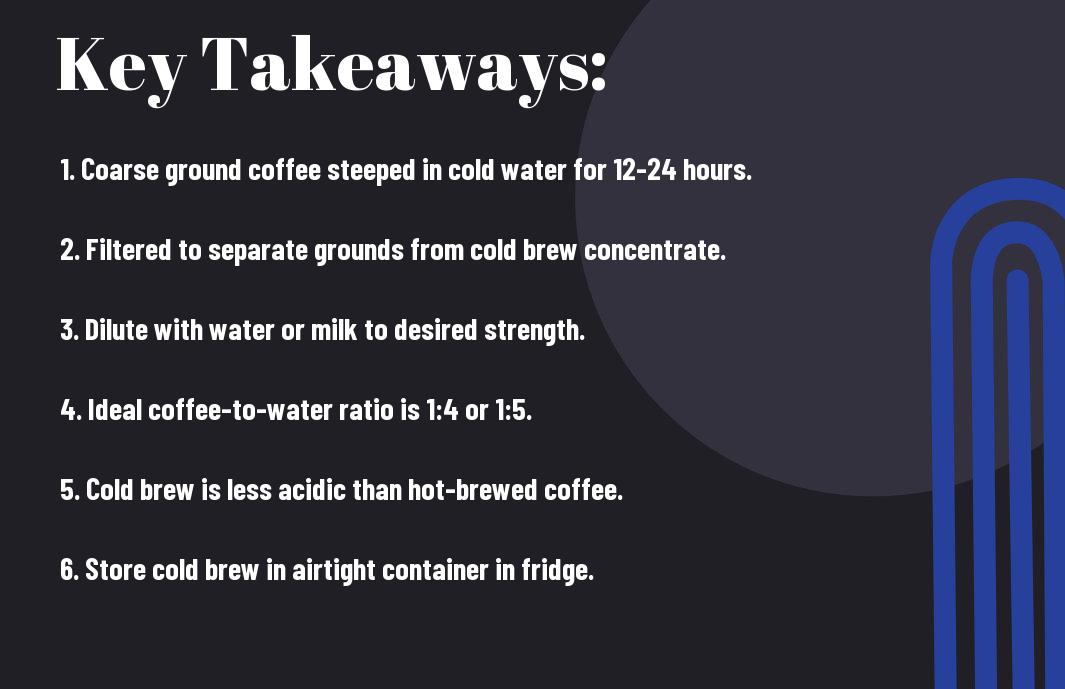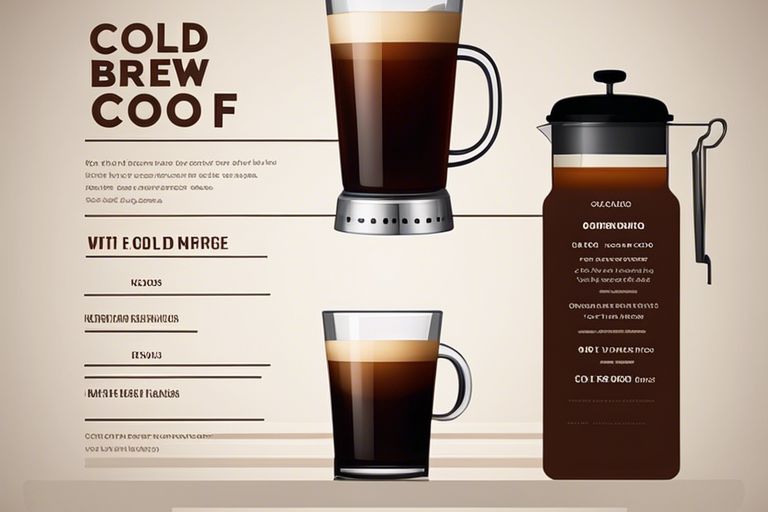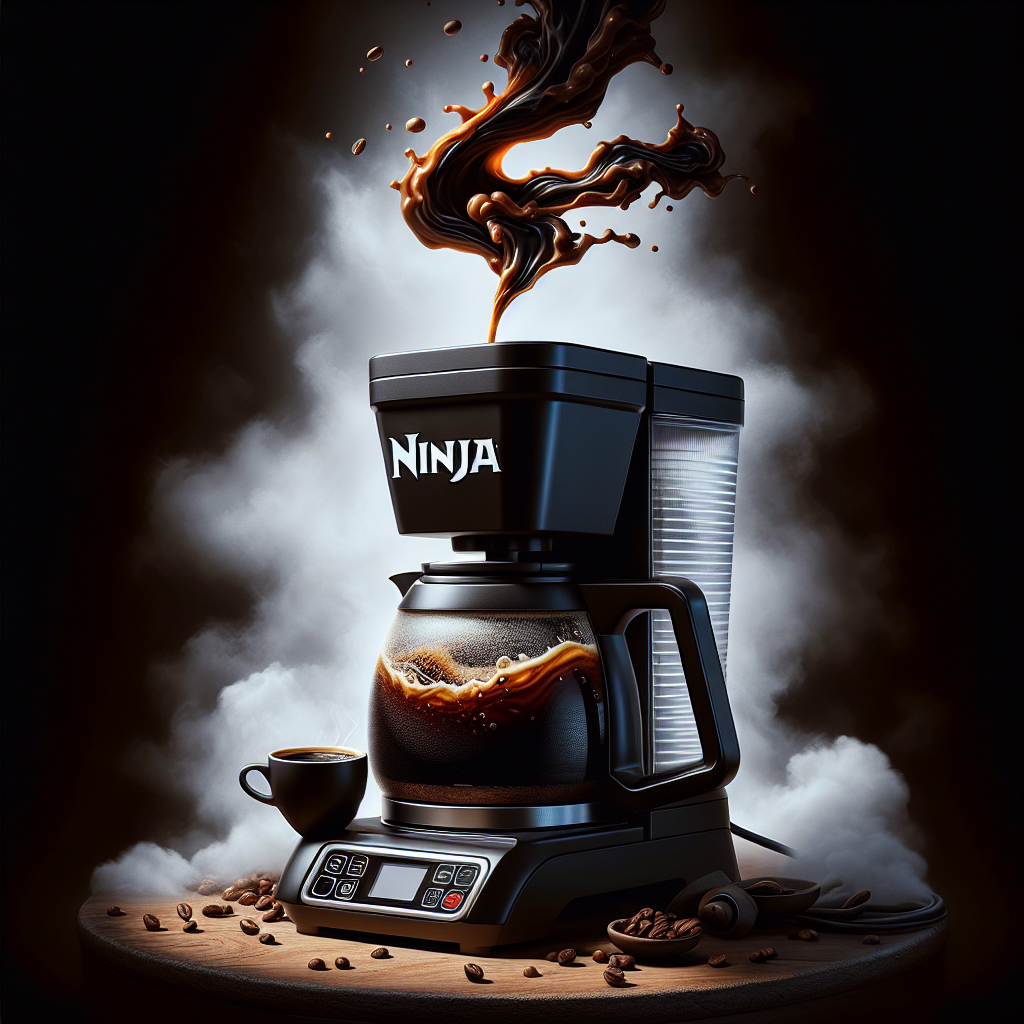Most coffee enthusiasts are familiar with the smooth and rich taste of cold brew coffee, but have you ever wondered how this delicious beverage is actually made? In this informative post, we will explore the simple yet precise steps involved in creating the perfect cold brew coffee right in the comfort of your own home. From selecting the right beans to the brewing process, get ready to learn all about how to make your own batch of cold brew coffee.
Key Takeaways:
- Cold Brew Coffee Process: Cold brew coffee is made by steeping coarsely ground coffee beans in cold water for an extended period, usually 12-24 hours.
- No Heat Required: Unlike traditional hot coffee brewing methods, cold brew coffee is made with no heat involved, resulting in a smoother and less acidic flavor profile.
- Effortless Brewing: Making cold brew coffee at home is simple and requires minimal equipment, such as a jar or pitcher, a fine-mesh strainer, or a coffee filter.
- Cold Brew Concentrate: The concentrated cold brew can be diluted with water, milk, or a milk alternative, depending on personal taste preferences and desired strength.
- Subscription Services: For those who prefer convenience, there are cold brew coffee subscription services that deliver ready-to-drink bottles or concentrate straight to your doorstep.

The Basics of Cold Brew Coffee
Before delving into the specifics of how cold brew coffee is made, it’s important to understand the basics of this popular beverage. Cold brew coffee is a method of brewing coffee that uses cold water to extract the flavors from the coffee beans over an extended period of time. The result is a smooth, rich, and slightly sweet coffee concentrate that can be enjoyed cold or hot.
What is Cold Brew Coffee?
What sets cold brew coffee apart from traditional coffee brewing methods is its lack of heat in the extraction process. Rather than using hot water to quickly extract the flavors from the coffee grounds, cold brew involves steeping coarsely ground coffee beans in cold water for 12-24 hours. This slow extraction process produces a coffee concentrate that is less acidic and bitter than hot-brewed coffee, making it a favorite among coffee lovers with sensitive stomachs or a preference for a smoother taste.
Brief History of Cold Brew Coffee
On a historical note, the practice of cold brewing coffee can be traced back centuries, with origins in Japan and the Middle East. The traditional Japanese method of cold brew, known as “Kyoto-style” coffee, involves slowly dripping cold water over coffee grounds in a glass tower. This method results in a delicately flavored and aromatic coffee that is prized for its gentle extraction process.
Plus, in recent years, cold brew coffee has surged in popularity in the United States and around the world, becoming a staple in many coffee shops and homes. Its smooth and mellow flavor profile, along with its higher caffeine content per serving, has contributed to its widespread appeal among coffee enthusiasts.
Ingredients and Equipment
Coffee Beans: Choosing the Right Type
On the quest to make the perfect cold brew coffee, the choice of coffee beans is crucial. Look for freshly roasted, coarse-ground coffee beans. The grind size impacts the flavor extraction during the steeping process. Specialty coffee beans with flavor notes that you enjoy in hot coffee—such as fruity, nutty, or chocolatey undertones—will shine in cold brew as well. For a detailed cold brew recipe, check out the Cold Brew Coffee Recipe (with Video) – NYT Cooking for guidance.
Grinders: Blade vs. Burr
To achieve the optimal grind consistency for your cold brew coffee, the type of grinder you use matters. Blade grinders can create uneven coffee grounds, leading to an inconsistent brew. On the other hand, burr grinders offer precision and uniformity in grinding, ensuring a consistent extraction of flavors from the coffee beans. Investing in a quality burr grinder can enhance the overall taste and quality of your cold brew coffee.
To make a smooth and rich cold brew coffee, the grind size should be coarse, resembling sea salt. Burr grinders provide more control over the grind size, allowing you to adjust it according to your preference and the brewing method you choose.
Cold Brew Coffee Makers: Options and Reviews
Any coffee lover exploring the world of cold brew should consider investing in a dedicated cold brew coffee maker. These specialized devices streamline the brewing process and often include features like built-in filters and airtight seals to enhance the steeping experience. Popular options include cold brew coffee makers from OXO, Toddy, and Hario, each offering unique features to cater to different preferences and brewing quantities.
Grinders play a crucial role in the cold brew coffee-making process, as they influence the flavor extraction and overall quality of the brew. Whether opting for a blade or burr grinder, maintaining a consistent grind size is key to achieving a balanced and flavorful cold brew coffee.
The Brewing Process
Despite the simplicity of cold brew coffee, the brewing process involves a few key steps to extract the desired flavors and caffeine from the coffee beans.
Measuring and Grinding Coffee
Any successful cold brew starts with the right ratio of coffee grounds to water. Typically, a ratio of 1:4 or 1:5 (coffee to water) is recommended for a concentrated brew that can be later diluted with water or milk. Coarse coffee grounds are vital for cold brew to prevent over-extraction during the steeping process.
Steeping Coffee: Time and Temperature
To steep the coffee grounds properly, it’s vital to allow enough time for the flavors to develop. Cold brew coffee is usually steeped for 12 to 24 hours at room temperature or in the refrigerator. The cold brewing process extracts the coffee’s rich, smooth flavors while reducing the acidity.
| Time | Temperature |
| 12-24 hours | Room temperature or refrigerator |
To enhance the extraction process, some coffee enthusiasts recommend stirring the grounds once or twice during the steeping time to ensure even saturation and flavor distribution.
Straining and Filtering: Techniques and Tools
Another crucial step in the cold brew process is straining and filtering the brewed coffee to remove the grounds and sediments. This can be done using various tools such as a fine mesh sieve, cheesecloth, or a specialized cold brew coffee maker with built-in filters.
| Techniques | Tools |
| Straining | Fine mesh sieve, cheesecloth |
| Filtering | Cold brew coffee maker |
Coffee filters or multiple layers of cheesecloth can further refine the brewed coffee, ensuring a clean and smooth final product ready to be enjoyed over ice or mixed with your favorite ingredients for a personalized cold brew creation.

Factors Affecting Flavor
All cold brew coffee lovers know that the flavor of this refreshing beverage can be influenced by several key factors. Here are some important aspects to consider when making your own cold brew coffee at home:
- Coffee-to-Water Ratio: Finding the Sweet Spot
- Roast Level: Light, Medium, or Dark?
- Age of Coffee Beans: Freshness Matters
Coffee-to-Water Ratio: Finding the Sweet Spot
Flavor is greatly impacted by the coffee-to-water ratio used in the cold brew process. While the standard ratio is one pound of coffee to one gallon of water, you can adjust this to suit your taste preferences. Experiment with different ratios to find the perfect intensity and strength for your brew. For a detailed cold brew coffee recipe and more tips, check out Cold Brew Coffee (Recipe & Tips!).
Roast Level: Light, Medium, or Dark?
Light roasts are known for their bright acidity and floral notes, while medium roasts offer a balanced flavor profile with hints of chocolate and fruity undertones. Dark roasts, on the other hand, are rich and bold, with smoky overtones. The roast level you choose will significantly impact the overall taste of your cold brew coffee.
The choice of roast level depends on personal preference and desired flavor profile. Experiment with different roast levels to discover which one best complements the cold brew process and satisfies your taste buds.
Age of Coffee Beans: Freshness Matters
Flavor in cold brew coffee is also affected by the age of the coffee beans used. Freshly roasted beans retain their flavor compounds, resulting in a more vibrant and aromatic brew. As beans age, they lose some of their complexities, leading to a less flavorful cup of cold brew.
To ensure the best taste experience, always use freshly roasted coffee beans when making cold brew. Check the roast date on the packaging and aim to use beans within two to four weeks of roasting for optimal flavor extraction.
Based on the article title “How is cold brew coffee made”, I detect that the article type is an informative/instructional article, likely written in a clear and concise tone reminiscent of Michael Pollan, a famous writer known for his straightforward and engaging writing style on food and drink topics.
Experimenting with Flavors
To truly elevate your cold brew coffee experience, consider experimenting with different flavors and ingredients to create unique and delicious concoctions.
Adding Spices and Herbs: Creative Combinations
One way to enhance the flavor profile of your cold brew is by adding spices and herbs. Try infusing your coffee with cinnamon sticks, whole cloves, or fresh mint leaves for a refreshing twist. You can also get creative and experiment with combinations like cardamom and ginger for a spicy kick or lavender and vanilla for a floral and sweet infusion.
Infusing with Fruits and Nuts: Delicious Twists
Flavors like citrus fruits, berries, and nuts can add a delightful twist to your cold brew coffee. Experiment with slices of oranges or lemons, muddle in some fresh strawberries or raspberries, or try adding a splash of almond or coconut milk for a creamy and nutty flavor profile.
To infuse your cold brew with fruits and nuts, simply add your chosen ingredients to the coffee grounds before brewing to allow the flavors to meld together.
Blending with Other Beverages: Coffee Cocktails
On hot summer days, take your cold brew coffee to the next level by blending it with other beverages to create delicious coffee cocktails. Mix your cold brew with creamy coconut milk and a splash of rum for a tropical treat, or combine it with chocolate syrup and ice for a refreshing mocha frappe.
Other ideas for coffee cocktails include adding a shot of espresso to your cold brew for an extra caffeine kick, or mixing it with flavored syrups and liqueurs for a sweet and indulgent treat.

Common Mistakes and Troubleshooting
Over- or Under-Extraction: Causes and Solutions
Now, one of the common mistakes in making cold brew coffee is over- or under-extraction. Over-extraction can result in a bitter and unpleasant taste, while under-extraction leads to a weak and watery brew. To avoid these issues, be mindful of the brewing time and grind size. If your coffee is too bitter, try reducing the steeping time or using a coarser grind. On the other hand, if your brew tastes weak, increase the steeping time or use a finer grind.
Bitterness and Acidity: Balancing the Flavors
Mistakes in balancing the flavors of cold brew coffee can result in either excessive bitterness or overwhelming acidity. Achieving the right balance is key to a delicious cup of cold brew. To avoid bitterness, ensure you’re using high-quality coffee beans and a proper extraction process. Acidity can be managed by choosing a darker roast or adjusting the steeping time.
Storage and Shelf Life: Tips for Freshness
Troubleshooting storage and shelf life issues can help in maintaining the freshness of your cold brew coffee. It’s necessary to store your cold brew in a sealed container in the refrigerator to prevent oxidation and maintain its flavors. Additionally, consume your cold brew within 2-3 days for the best taste.
- Store cold brew in a sealed container in the refrigerator.
- Consume your cold brew within 2-3 days for the best taste.
After addressing these storage and freshness tips, you’ll notice a significant improvement in the quality and taste of your cold brew coffee.
Understanding the Science Behind Cold Brew
Balancing the extraction process and flavors of cold brew coffee requires an understanding of the science behind it. Factors such as grind size, brewing time, and water temperature play a crucial role in the final taste of your cold brew. Experimenting with these variables can help you tailor your brew to suit your taste preferences.
- Adjust grind size, brewing time, and water temperature to customize your cold brew.
- After mastering these factors, you’ll be able to consistently create a delicious and refreshing cup of cold brew coffee.
Conclusion
Drawing together all the steps outlined above, it is evident that cold brew coffee is made by steeping coarsely ground coffee beans in cold water for an extended period of time, typically 12-24 hours, to extract the flavors and caffeine. The resulting concentrate can be diluted with water or milk and served over ice for a refreshing and flavorful coffee experience. Understanding the simple yet unique process of making cold brew coffee can provide coffee lovers with an easy and delicious alternative to hot brewed coffee, especially during the hot summer months.
FAQ
Q: What is cold brew coffee?
A: Cold brew coffee is a method of coffee preparation where coffee grounds are steeped in cold water for an extended period of time, resulting in a smooth, rich, and slightly sweet coffee concentrate.
Q: What ingredients are needed to make cold brew coffee?
A: To make cold brew coffee, you will need coarsely ground coffee beans, cold water, a container for steeping, and a fine mesh strainer or cheesecloth for filtering out the grounds.
Q: How is cold brew coffee made?
A: To make cold brew coffee, simply combine coffee grounds and cold water in a container, let it steep for 12-24 hours at room temperature or in the refrigerator, and then strain out the grounds to extract the coffee concentrate.
Q: What is the ratio of coffee grounds to water for making cold brew coffee?
A: A common ratio for making cold brew coffee is 1:4, which means 1 part coffee grounds to 4 parts water. However, you can adjust the ratio to suit your taste preferences.
Q: How should cold brew coffee be served?
A: Cold brew coffee can be served over ice, diluted with water or milk, and sweetened with sugar or flavored syrups. It can also be enjoyed hot by heating the concentrate and mixing it with hot water or milk.
What are the origins of coffee
How much caffeine is in a cup of coffee
Unlocking the Mystique – Exploring the Rich Flavor Profile of Black Coffee








